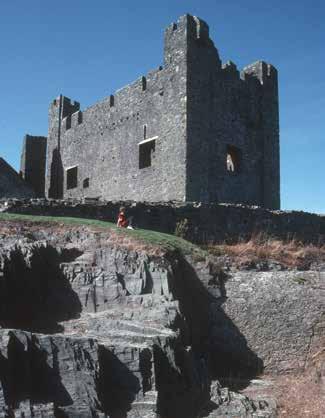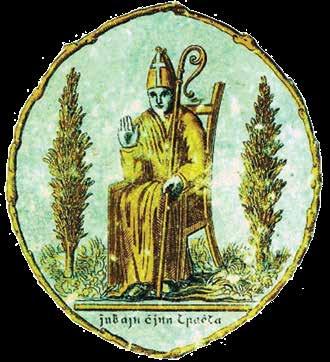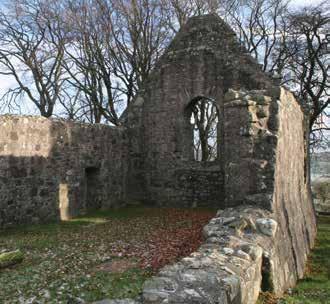
4 minute read
Medieval people and the sea
Early Christians
The arrival of Christianity in Ireland in the 5th century AD introduced a new type of settlement into the Irish landscape – the monastery. Fish was an important part of the monastic diet and monks exploited the resources of local rivers and the sea.
Advertisement
The best documented early monastic site in the area is at Killevy, founded as a nunnery in the later 5th century by St. Moninne at the foot of Slieve Gullion.
Viking impact
As centres of wealth, learning and craftsmanship, Early Christian monasteries in coastal areas were an obvious focus for attack by the Vikings who first arrived in Ireland from Scandinavia in 795 AD. By the mid 9th century, they were establishing raiding camps – longphorts - to allow raiding parties to over-winter and raid farther inland.
The Carlingford region was a significant area of Viking activity. The Vikings gave Carlingford Lough its name, which reminded them of the fjords (sea inlets) of their homeland in Norway.
Cistercian monks and AngloNorman knights
The 12th century witnessed extensive reform within the church in Ireland. One aspect of these changes was the introduction of the Cistercian monastic order. In 1153, twelve monks from Mellifont set up a Cistercian monastery at Newry under the patronage of Dermot O’Carroll, King of Oriel.
The estates of the abbey were organised into a system of granges or farms. The Clanrye river system with its tributary streams was utilised to provide power for corn mills and drainage for the monastic 8 buildings. Cistercian monks were originally vegetarian but they were eventually allowed to eat meat and fish on feast days. They would have used local water supplies to create artificial fish ponds, and fish weirs were established on the Clanrye River to catch salmon. Shellfish would also have been caught in Carlingford Lough.
The Anglo-Normans, who arrived in Ireland in the latter part of the 12th century recognised the strategic importance of Carlingford Lough. Large stone castles were built at Carlingford and Greencastle. A port grew up at Carlingford and this became an important link in medieval coastal communication routes and Irish Sea trade. A town also appears to have developed in Newry at this time, possibly at the gates leading to the abbey precinct.
Greencastle, County Down
© William McAlpine Built c.1250 by the Anglo-Normans, Greencastle commanded the entry to Carlingford Lough along with King John’s Castle at Carlingford on the opposite shore. A ferry connected the two castles and coastal trade with Dublin and other ports made them essential to Anglo-Norman military and economic control of the area.
Classroom Activities
1. Study the story of St. Patrick and find out where he came from and how he arrived in Ireland. Newry is traditionally associated with St.
Patrick. Find out what other towns and places are associated with
Ireland’s patron saint.
2. Explore the reasons why Carlingford Lough was attractive to the Vikings.
3. A monastic diet involved the eating of fish. The monks fished in the surrounding rivers, lakes and sea and built their own fishponds. Find out the different types of fish that would have been available.

Image of the old Seal of Newry
Newry and Mourne Museum Collection Local tradition states that St. Patrick planted a yew tree on a hill overlooking the estuary of the Clanrye River - Iubhair Cinn Traghta (“the Yew tree at the head of the strand”), shortened to Na Iubhair and then to Newry. This legend is commemorated on the old town seal which features the abbot of the Cistercian monastery flanked on either side by a Yew tree. A Cistercian monastery was founded at Newry in 1153 possibly on the site of an earlier monastic settlement.
Killevy Churches

© Newry and Mourne Museum (photograph by Christina Joyce) The early convent at Killevy was ideally located to make use of the fishing resources of Camlough. Its proximity to Carlingford Lough was useful for trade and communication, but made it an easy target for the Vikings who raided it in 923 AD.
• ARMAGH LOUGH NEAGH
ULSTER
STRANGFORD LOUGH
NEWRY •
KILLEVY •
CORNAMUCKLAGH • KILNASAGGART •
LEINSTER
• NARROW WATER CARLINGFORD LOUGHCARLINGFORD • • KILBRONEY
IRISH SEA
ANNAGASSAN •
Map showing Early Christian and Viking sites in the Carlingford region
The area around Carlingford Lough is rich in Early Christian sites. A number of these were attacked by the Vikings who began raiding the coastal areas of Ireland from the later 8th century onwards. The Vikings subsequently settled at the foot of Slieve Foy (Carlingford) and established a raiding camp at Annagassan in 841 and another one at Narrow Water. They used Carlingford Lough as a base from which to raid further inland, particularly Armagh.







